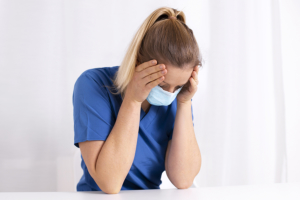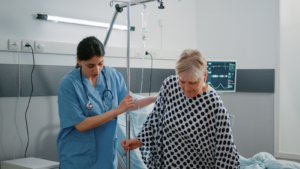Congress Newsletter 2022
Residency challenges - including fatigue and being a working mum
Session 16P5: today Monday 6 June, 1400-1500H, Room Amber 3
This three-part session will address several important issues affecting the daily lives of anaesthesiologists, including fatigue and being a working mum. Our Scientific Programme Chair Prof Idit Matot will open the session with a talk on “making yourself understood”.
Following this, Dr Elena Gjorchevska, will ask “When it comes to our work as trainees on one side and parenthood on the other side, is it even possible to achieve balance?” Elena is an anaesthesiology trainee at the University Clinic for Anaesthesia, Reanimation and Intensive Care, Skopje, North Macedonia.
She says: “First, I’m going to share some facts from different surveys and research on pregnancy, motherhood, maternal wellbeing, burnout and fatigue in new parents-trainees. Then, I’m going to share my personal insights and some things I’ve learned so far as a trainee and a new mom, which I hope will be helpful.”
Recent surveys show high rates of burnout in young anaesthesia specialists and trainees. Given the fact that those are the same years when most of us become new parents, the rates of fatigue, sleep deprivation, emotional exhaustion and depersonalisation leading to anxiety and depression are very common.
So, how can you achieve work-life balance and stay happy and healthy?
- Embrace the chaos!
- Be prepared for occasional day-to-day imbalance.
- Be aware of how your brain works (early bird or night owl?).
- Plan ahead.
- Stay focused on long-term goals.
- Communicate and ask for help.
- “Me” time.
- Keep in mind your daily goals, and take things as they come.
- Practice positive thinking & gratification.
- Nothing lasts forever. Even the “BAD”.
A talk on the potentially lethal effects of fatigue on doctors and nurses themselves, and its impact on the quality of their clinical work and judgement and therefore patient safety, will be given by Consultant Anaesthetist Dr Nancy Redfern of Newcastle Hospitals NHS Foundation Trust, Newcastle, UK. She will conclude that due to these risks, “healthcare should have formal risk management systems like those required by law in every other safety-critical industry”.
She will also recommend that all doctors and nurses need 20-minute power naps during night shifts to keep patients safe (and make their own journeys home after work safer), and also recommend that no doctor or nurse does more than 3 consecutive night shifts.
Dr Redfern will discuss evidence from various sources including surveys from the joint Association of Anaesthetists, Royal College of Anaesthetists and Faculty of Intensive Care Medicine fatigue working group, published in the journal Anaesthesia, that showed around half of the trainee doctors, consultants and nurses had experienced either an accident or a near-miss driving home after a night shift. Indeed, research has shown driving after being awake for 20 hours or more and at the body’s circadian low point (in the night or very early morning when it most needs sleep) is as dangerous as driving with blood alcohol levels above the legal limit. And workers who drive home after 12-hour shifts are twice as likely to crash as those working 8-hour shifts.
A ‘sleep debt’ begins building after 2 or more nights of restricted sleep, and it takes at least 2 nights of good sleep to recover from this. Cognitive function is impaired after 16-18 hours awake leading to a deterioration in the medical worker’s ability to interact effectively with patients and colleagues. “When fatigue sets in, we in the medical and nursing team are less empathic with patients and colleagues, vigilance becomes more variable, and logical reasoning is affected, making it hard to calculate, for example, the correct doses of drugs a patient needs,” explains Dr Redfern. “We find it hard to think flexibly or to retain new information which makes it difficult to manage quickly changing emergency situations. Our mood gets worse, so our teamwork suffers. Hence, everything that makes us and our patients safe is affected.”
She will discuss how fatigue induces spontaneous, unrecognised uncontrolled ‘sleep lapses’ or ‘microsleeps’, which means driving home tired is the most dangerous thing a healthcare practitioner does. Evidence around short 20-minute power naps in improving staff and patient safety will be presented and ways of building this into night shift work discussed.
There is work going on at many levels to address the impact of fatigue. The European Society of Anaesthesiology and Intensive Care is working on producing guidelines for night working, while the Association of Anaesthetists has an active #fightfatigue campaign. The European Board of Anaesthesiology and the European Patient Safety Foundation are also active in this area, and Dr Redfern notes that several European countries are leading the way with action, including the UK, Romania, The Netherlands and Portugal.
Dr Redfern explains: “We hope in the end that regulators will recognise that healthcare workers have the same physiology as employees in every other safety-critical industry and require formal fatigue risk management as part of its overall approach to patient and staff safety.”
She concludes: “We need to change the way we manage night shifts to mitigate the effects of fatigue. Those working shifts must ensure everyone gets a power nap, and that we support each other to remain safe and vigilant when we work through the night. Staffing schedules should allow sufficient time between shifts for proper rest, and no one should do more than 3-night shifts in a row.”
References for Dr Redfern’s talk:
*For a previously published survey on the effects of fatigue, see: A national survey of out‐of‐hours working and fatigue in consultants in anaesthesia and paediatric intensive care in the UK and Ireland (wiley.com)
https://associationofanaesthetists-publications.onlinelibrary.wiley.com/doi/full/10.1111/anae.13965
and
A national survey of the effects of fatigue on trainees in anaesthesia in the United Kingdom. Anaesthesia 2017 https://associationofanaesthetists-publications.onlinelibrary.wiley.com/doi/full/10.1111/anae.13965
Further background reading, also from the journal Anaesthesia, an editorial from Australia by Prof Drew Dawson and Dr Matthew Thomas based at Central Queensland University – setting up a fatigue risk management in healthcare in Queensland. This gives background and some of the science.
https://associationofanaesthetists-publications.onlinelibrary.wiley.com/doi/epdf/10.1111/anae.14833
**For the Association of Anaesthetists Fatigue Campaign, see: https://anaesthetists.org/Home/Wellbeing-support/Fatigue/Help-Fight-Fatigue
In the UK, the Association of Anaesthetists, Royal College of Anaesthetists and Faculty of Intensive Care Medicine fatigue working group have prioritised fatigue and a link to the Association’s fatigue campaign and infographics from the joint working group can be found above.
Read More of our special newsletter covering our congress.











